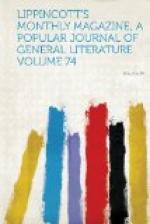No need to ask, “Where are we to go?” All roads lead to the first sod to-day. We are just a moment late: F—— has to get out of the carriage and plunge into the sand, madly rushing off to find and fall into his place in the procession, and we turn off to secure our seats in the grand stand. But before we take them I must go and look at the wheelbarrow and spade, and above all at the “first sod.” For some weeks past it has been a favorite chaff with us Maritzburgians to offer to bring a nice fresh, lively sod down with us, but we were assured D’Urban could furnish one. Here it is exactly under the triumphal arch, looking very faded and depressed, with a little sunburned grass growing feebly on it, but still a genuine sod and no mistake. The wheelbarrow was really beautiful, made of native woods with their astounding names. All three specimens of the hardest and handsomest yellow woods were there, and they were described to me as, “stink-wood, breeze-wood and sneeze-wood.” The rich yellow of the wood is veined by handsome dark streaks, with “1876” inlaid in large black figures in the centre. The spade was just a common spade, and could not by any possibility be called anything else. But there is no time to linger and laugh any longer beneath all these fluttering streamers and waving boughs, for here are the Natal Carbineers, a plucky little handful of light horse clad in blue and silver, who have marched, at their own charges, all the way down from Maritzburg to help keep the ground this fine New Year’s Day. Next come a strong body of Kafir police, trudging along through the dust with odd shuffling gait, bended knees, bare legs, bodies leaning forward, and keeping step and time by means of a queer sort of barbaric hum and grunt. Policemen are no more necessary than my best bonnet: they are only there for the same reason—for the honor and glory of the thing. The crowd is kept in order by somebody here and there with a ribboned wand, for it is the most orderly and respectable crowd you ever saw. In fact, such a crowd would be an impossibility in England or any highly-civilized country. There are no dodging vagrants, no slatternly women, no squalid, starving babies. In fact, our civilization has not yet mounted to effervescence, so we have no dregs. Every white person on the ground was well clad, well fed, and apparently well-to-do. The “lower orders” were represented by a bright fringe of coolies and Kafirs, sleek, grinning and as fat as ortolans, especially the babies. Most of the Kafirs were dressed in snow-white knickerbockers and shirts bordered by gay bands of color, with fillets of scarlet ribbon tied round their heads, while as for the coolies, they shone out like a shifting bed of tulips, so bright were the women’s chuddahs and the men’s jackets. All looked smiling, healthy and happy, and the public enthusiasm rose to its height when to the sound of a vigorous band (it is early yet in the day, remember, O flute and




